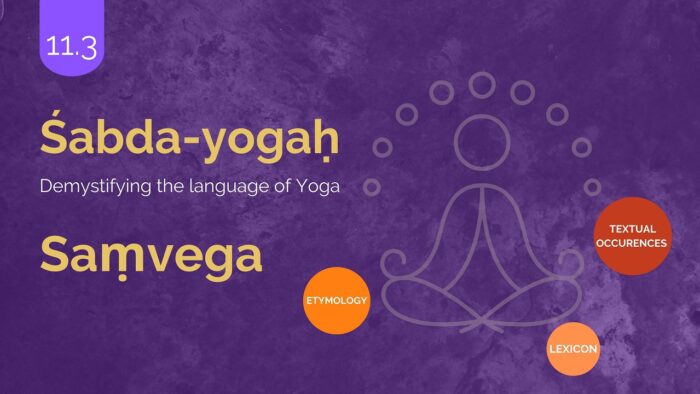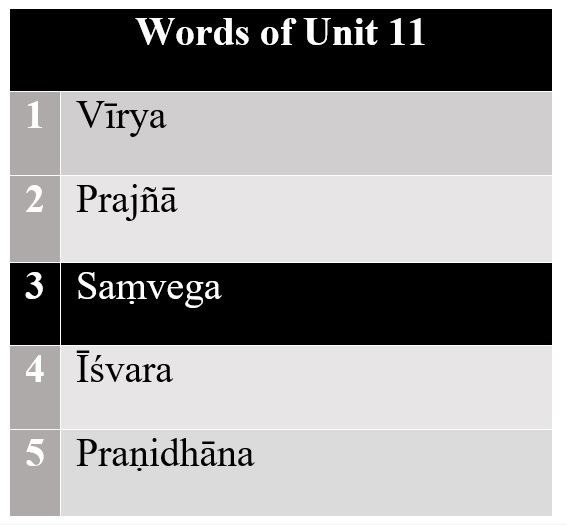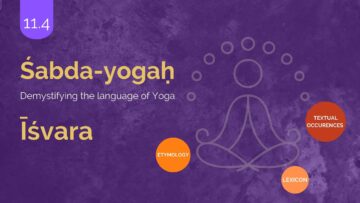Introduction
In this series, Yogic terminologies will be taken up and their –
- Etymological analysis,
- Lexical descriptions and
- Textual occurrences in Yogic literature and their commentaries, as available, will be presented. And finally observations will be made on the references.
Three texts – Yogasūtra, Haṭha-yoga-pradīpikā and Bhagavad-gītā are consulted for textual occurrences portion.
Śabda-yoga is intended to help students, teachers, and professionals of Yoga to develop a sound grammatical, contextual, and thereby an authentic and immersive understanding of Yoga terminologies.
List of Words
We will take up important Yogic terms from Sūtra-s 1.20 – 23. The terms that will be analyzed in this Unit are –
Etymology
सम् + विज+ घञ् = संवेगः
sam + vija+ ghañ = saṃvegaḥ
- The prefix here is sam– which means सम्यक् – well
- The root is विज्भयचलनयोः – vijbhayacalanayoḥ – to fear and to move
- The suffix is ghañ – which is used to indicate the meaning भाव –bhava – the act of. The suffix is added based on the grammatical rule भावेbhāve (aṣṭādhyāyī 3.3.18)
The derivation then would be सम्यक्विज्यतेइतिसंवेगः – the act of moving well/with intensity
Lexicon
…समौसंवेगसंभ्रमौ1.7.34.1.3
samausaṃvega-saṃbhramau
The words saṃvega and saṃbhrama are used to indicate some urgency and urge in action.
It is interesting to note that both the grammatical derivation and the lexicon reference match exactly in this case.
Textual Occurrences
Yogasūtra
There is just one occurrence of the term in this text. It is as follows –
तीव्रसंवेगानामासन्नः1.21
tīvrasaṃvegānāmāsannaḥ
Those with intense samvega – (the attainment of Samādhi) is quicker.
The word Samvega has been given the following meanings in the SaṃskṛtaYogasūtra commentaries.
- Bhojavṛttiḥ- क्रियाहेतुःदृढतरःसंस्कारः
kriyāhetuḥdṛḍhataraḥsaṃskāraḥ
That firm subliminal impression that impels into action
- Bhāvagaṇeśavṛttiḥ – अनुष्ठानेश्रैष्ठ्यम्, अविच्छेदश्च
anuṣṭhāneśraiṣṭhyam, avicchedaśca
Greatness in practice (of Yoga), unbroken continuity (of practice)
- vārttikam- अतिशयेनउपायानुष्ठानम्
atiśayenaupāyānuṣṭhānam
Practice of the methods (of Yoga) in an intense manner
- maṇiprabhā, yogasudhākāraḥ- वैराग्यम्vairāgyam
Dispassion
- bhāsvatī- निरन्तरानुष्ठानम्, इच्च्छाप्राबल्यम्
nirantarānuṣṭhānam, iccchāprābalyam
Constancy in practice and strong desire (to attain Samādhi)
Thus it could be seen that – Greatness/intensity in practice, continuous practice, being dispassionate (in things other than Yogic practices) and very strong desire – constitute the meaning of the term Samvega.
Bhagavadgītā & Haṭhayogapradīpikā
This term is not found in the text, But the spirit (intensity in practice etc.) conveyed by the term is found in the both text – albeit in other terms.
Tabulation of Textual References 11.3
Observations
It could be noted that the term is a unique to Yogasūtras, not be found in the other two Yoga texts. Even in the Yogasūtras the term appears just once.
It is interesting to note that the aspects of practice that are conveyed by Samvega through the commentaries have been enlisted in the Yogasūtras themselves – in the Sūtra (1.14) –
सतुदीर्घकालनैरन्तर्यसत्कारासेवितोदृढभूमिः
satudīrghakālanairantaryasatkārāsevitodṛḍhabhūmiḥ ….
It is also worth noting that – according to one commentator Samvega indicates vairāgya – which is one among the twin practices indicated earlier in the Sūtra 1.12-
अभ्यासवैराग्याभ्यांतन्निरोधः
abhyāsavairāgyābhyāṃtannirodhaḥ.
Thus it could be stated that the term Samvega – incorporates in itself both abhyāsa and vairagya.
Thus it can be stated that in just one term – Samvega – the essence of three Sūtras have been conveyed ((a) abhyasa (Sūtra 1.13) b) the qualities that make an abhyasa intense (Sūtra 1.14) c) Vairagya (Sūtra1.15)).
Such is the uniqueness of the coinage that emerges from the study of the interoperations of the term Samvega in the Saṃskṛta commentaries.
This unique nature of the term comes to the fore only by approaching the term with the śabda-yoga methodology.
Unit 11 To be Continued…
Links for previous posts in this unit
Disclaimer: The opinions expressed in this article belong to the author. Indic Today is neither responsible nor liable for the accuracy, completeness, suitability, or validity of any information in the article.













